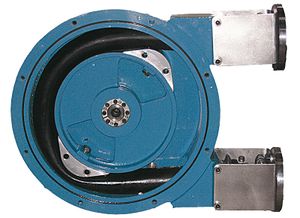Hose Pumps
Hose Pumps can typically operate against up to 16 bar in continuous service, use shoes and have casings filled with lubricant to prevent abrasion of the exterior of the pump tube and to aid in the dissipation of heat, and use reinforced tubes, often called hoses. This class of pump is often called a hose pump.
The hoses in a hose pump are typically reinforced, resulting in a very thick wall. For a given ID the hoses have much bigger OD than a tubing for the roller pump. This thicker wall, combined with a stiffer material typically used in the hoses make the forces necessary to occlude the hose much greater than for the tubing. This results in a bigger and slower pump and motor for a given flow rate with the hose pump than the roller pump, consuming more energy to run.
The biggest advantage with the hose pumps over the roller pumps is the high operating pressure of up to 16 bar. With rollers max pressure can arrive up to 12 bar without any problem. If the high operating pressure is not required, a tubing pump is a better option than a hose pump if the pumped medium is not abrasive. With recent advances made in the tubing technology for pressure, life and chemical compatibility, as well as the higher flow rate ranges, the advantages that hose pumps had over roller pumps continues to erode.
